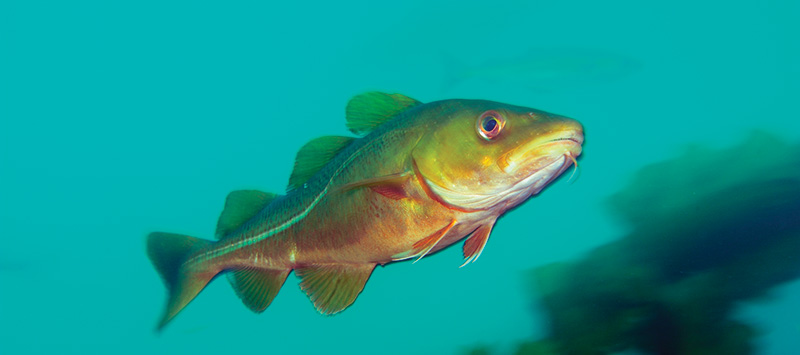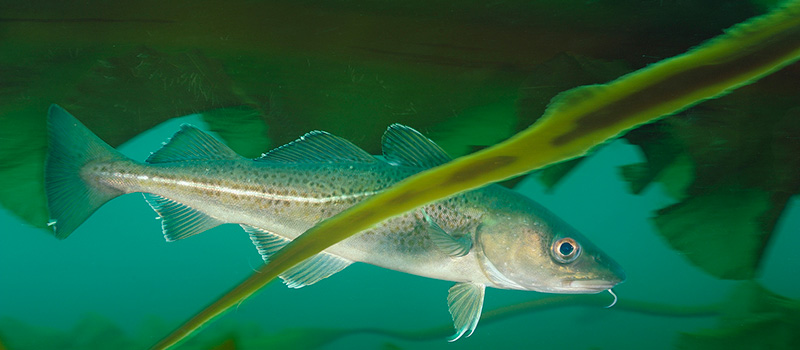For centuries, Atlantic cod has been essential to New England’s identity. Yet today, you can rarely find locally caught cod in a grocery store or on a menu – because it has been fished to the brink of disaster.
Because of historically low population counts in 2019, New England fishermen can no longer catch enough cod to make a profit. How did the numbers of this iconic species – once so plentiful that it became the backbone of local identity and industry – plummet to such levels?
“Overfishing got us here,” says CLF Senior Science Fellow Dr. Gareth Lawson, “and climate change is going to make it harder for us to get out.”
As a marine scientist, Lawson has spent upwards of 100 days a year on small vessels, waded through cod nurseries, and tagged hundreds of the fish. He enjoys fishing and prefers to eat cod salted since an old skipper in Newfoundland taught him the art.
Though scientists are encouraged to maintain neutral positions, Lawson has witnessed Atlantic cod’s downward trajectory firsthand and knows the stakes are high. “There’s this narrative among some commercial fishermen that there are tons of fish out there, that fishermen can’t get away from cod. But all of the available, independent data suggests otherwise. We can’t risk fishing the last vestiges of a population.”
Lawson moved from academia into advocacy when he became tired of just describing the problem. “It’s time to talk about solutions,” he says. “Ultimately, the fish need refuge. These are last gasp populations we have to protect. This is about standing up for science and saving fish for future generations.”
Others at CLF feel this urgency as well. “The window for rebuilding the cod population in New England is closing rapidly,” says CLF’s senior counsel, Peter Shelley, who has advocated for sustainable fisheries for decades. “The species is in real trouble, and it’s essential to ensure all fish populations are as resilient as possible before the stress of climate change alters environments even further.”

Why haven’t people been more motivated to protect cod in the way we often protect birds or land animals?
“Here’s the thing about cod,” Lawson says, “or fish in general. People don’t see what they do. Even if you’re a fisherman, you bring a fish up on deck, and it’s dead. The fish don’t talk or express displeasure. So we don’t think about their lives.”
Lawson, however, has learned to see more deeply – literally. “What grabbed me about cod is that, through technologies like submarine exploration and sonar, I could finally see what’s happening beneath the surface,” he says. “I’m motivated by an appreciation of their complexity.”
Lawson wishes that people could witness the elaborate cod mating display the same way they might watch a sage grouse ritual on the prairie. “With sonar, you can see their spawning columns, which used to be common in Newfoundland before overfishing,” he says. Cod are known to vocalize, making a grunting sound by using muscles and contracting the swimbladder during spawning. There’s also evidence that a more complex mosaic of spawning grounds once existed in New England.
“Cod tend to have fixed patterns, often returning to the same spawning and feeding grounds,” Lawson says. Some scientists believe that there aren’t many older fish left to lead younger fish to their historic spawning grounds. What’s more, many of those grounds have been wiped out by destructive fishing practices like bottom trawling. The big, older female cod – which contribute exponentially more to successful spawning – have largely disappeared, as well, having been overfished for decades.
We can’t risk fishing the last vestiges of a population.
Dr. Gareth Lawson
Recommendations about how cod stocks are managed, such as whether to close an area during spawning season or set stricter catch limits, rest with an entity called the New England Fishery Management Council. Its recommendations are then approved and implemented by federal regulators at NOAA Fisheries.
In CLF’s view, the industry-dominated council has consistently prioritized short-term profit over the long-term health of the fishery and fishing communities – and NOAA Fisheries has routinely rubber-stamped its recommendations. As a result, Atlantic cod stocks on Georges Bank and in the Gulf of Maine are depleted and lack enough healthy adult fish to replenish populations to a healthy level.
The federal Magnuson-Stevens Act (MSA) was enacted in 1976 to prevent overfishing. It requires fishery managers in New England and seven other regions across the country to set catch limits based on the best available science and end overfishing to help stocks rebound. But New England managers – and the federal agency that approves their decisions – have not honored this law.
“In the face of uncertainty, you proceed with caution,” Lawson says. “You back off the maximum catch quotas. Otherwise, you find yourselves where we are now after years of chronic overfishing and a pattern of risky management choices.”
And where we are now, according to Allison Lorenc, a policy analyst at CLF, is in a cod fishery crisis. “The government has failed the fish and fishermen,” Lorenc says. “It has continually failed to make hard decisions and respect the legal mandates.” The only choice left, she says, is to take drastic action.
“CLF is calling for a temporary prohibition on cod fishing that will give the imperiled species room to breathe and, hopefully, recover,” says Lorenc. This action will be controversial and difficult in the short-term. However, without swift and effective measures now, there won’t be a cod fishery for future generations.
What would cod population recovery efforts look like in practice? Senior counsel Peter Shelley outlines the steps that must be taken to make even a modest recovery of New England cod possible:
1. Stop killing cod. Until we have better data to guide management decisions, and until cod start to make a meaningful recovery, no one should be fishing the species – commercially or recreationally. “This is by no means an outlandish call,” Shelley says. “By its own rules, the Council should shut down fishing for cod and reduce bycatch.” Cod must be left alone long enough to rebuild to healthy population levels in New England.
2. Monitor every fishing trip in New England’s groundfishery to track what is caught. That means understanding not only what is being caught and sold commercially, but what is being caught and thrown back in the sea, both within the cod fishery and by other groundfishing boats.
Strict catch limits have created an incentive for unreported or misreported catch. Without knowing how many cod are actually being caught, managers cannot ensure adherence to the catch limits and prevent overfishing. Better monitoring means better data and, ultimately, better management.
3. Close areas to protect spawning grounds and other important habitat. Managers need to let cod grow old enough to replenish populations. “The last remaining areas in our ocean where cod spawn and develop must be protected,” Shelley says. Managers must also protect habitat for large adult cod, such as Cashes Ledge in the Gulf of Maine.
4. Modify fishing gear to prevent bycatch of cod. Robust fisheries for other, more abundant species, like haddock, co-occur with cod; using modified gear will allow those other species to be fished while minimizing the unintentional killing of cod.
5. Implement a catch-and-release program for recreational fishermen. In addition to the prohibition on recreational cod fishing, such a program should still allow sport fishermen to target other groundfish without impacting the cod population.

Sadly, New England’s precarious cod population is not unique; Atlantic cod stocks have also crashed elsewhere in the world, resulting in similar difficult decisions. Newfoundland enacted a moratorium in 1992, ending 500 years of commercial fishing; its cod population is only slowly rebounding.
That crisis is where the Canadian-born Lawson got his start in cod. “I was in grad school four years after the Newfoundland cod crash. I was interested in fish and marine science, so cod was very topical,” he says. “That’s what got me into cod – but what got me hooked on cod was spending time on small boats and working with fishermen. It was the connection to the maritime communities, people, and culture of Newfoundland.”
Through those early experiences, Lawson understands how protecting a species can sometimes change the nature of a town. “They were so resilient,” he recalls, thinking of the locals in the Newfoundland fishing villages impacted by the cod crash.
In New England, the crisis is already being felt by the small- and midsize fishermen who could once count on cod for a comfortable livelihood for their families. Many of them are being driven out of business, unable to catch enough cod to make a living and powerless to compete with industrial fishing fleets that dominate the region’s other fisheries. While critical to the survival of the iconic species, a prohibition on cod fishing will further affect these struggling communities. But failing to protect cod may hurt them even more.
CLF realizes the complexity of this position, and no cod advocate relishes the economic hardship that will follow the necessary steps. “Despite what people might think, we are not anti-fishing, we’re anti-overfishing” policy analyst Lorenc says. “We want a better future for cod and for the communities that depend on it.”
“These are thorny problems,” Lawson acknowledges. “But we have to stand up for the species and the science.”
Today, none of the fishermen who plied New England’s waters prior to the 1980s would recognize the Atlantic cod population. Gone are the man-sized cod that were the stuff of local legend. Gone are the big old female fish able to replenish stocks. Without action now, gone, too, will be locally caught codfish fries in the heat of summer and the cultural hallmarks of what was once a more balanced relationship between man and fish.
